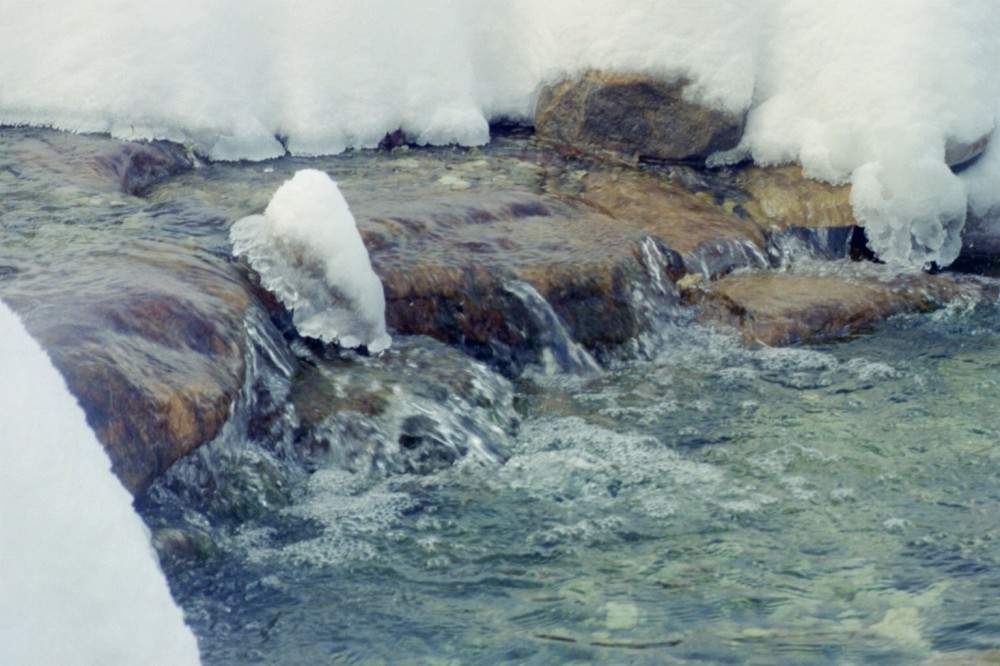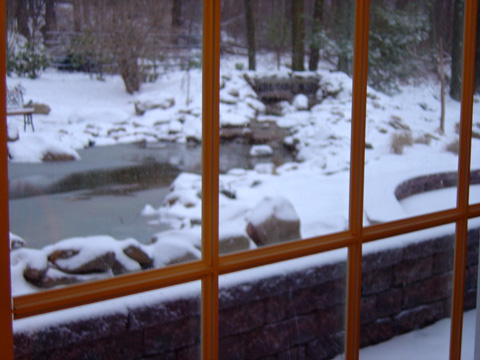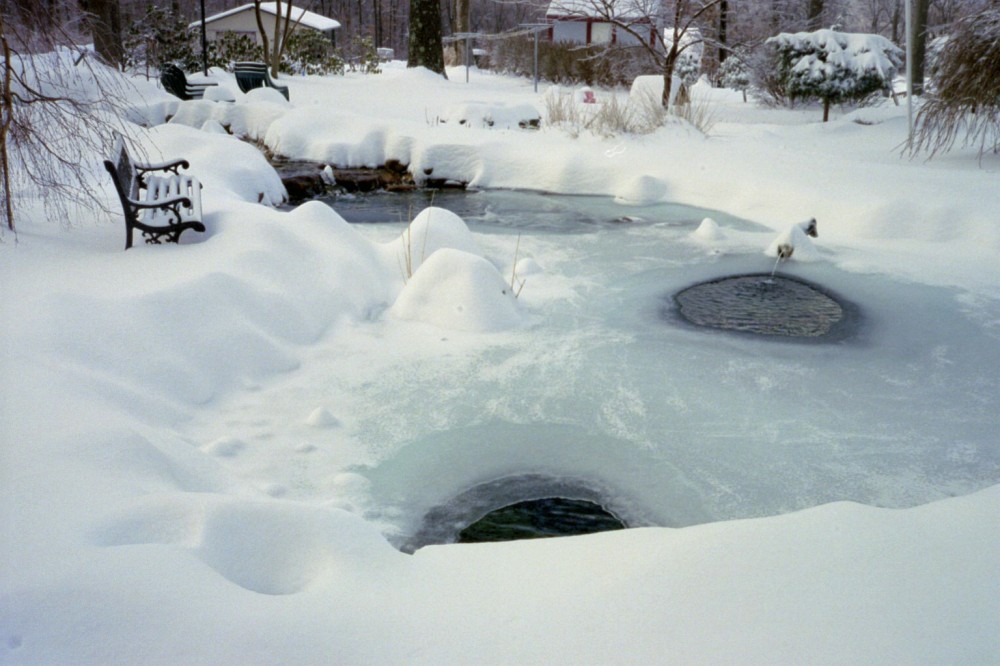You are here
Maintenance Pond Cleaning
The Spring Season
To Clean or Not to Clean?
Spring is simply the most exciting time of year. As things slowly awaken from their winter hibernation, there are some things that you can do to make sure your water feature gets off to a good start this spring.
Does your water feature need a full clean-out this season or does it just need to be tidied up a little? There are a couple of things that you can look for to help you decide. First, if there is a layer of “crud” at the bottom of the pond and the water is dark in color, it would be a good idea to do a full clean-out, especially if you live in the woods and your pond is full of leaves and other debris. Leaving this organic matter in your pond can cause excessive algae to grow in the spring, and it can increase the ammonia and nitrate levels and become harmful to the health of your fish.
On the other hand, if there is just a small amount of debris that you can stir up and capture with a net and the water looks clear, a little tidying up is all that’s in order. Plan on spending a half to a full day to complete a pond clean-out. A Pondless® Waterfall will take considerably less time.
The best time to perform a pond clean-out is the early spring, before your water garden completely awakens from its winter dormancy – ideally before the water temperature in the pond creeps above 55º F. If a clean-out is performed when the water is warmer, after bacteria colonies form, the balance of the ecosystem will again be thrown off and your pond will go through another “green phase” before the bacteria colonies re-establish themselves again.
Here’s what you’ll need to get started:
- A clean-out pump with approximately 25 ft. of discharge hose
- A high-pressure nozzle for your garden hose, or a power washer
- Garden shears for trimming plants
- A child’s swimming pool or a similar sized container to hold fish and any other critters you find during the clean-out
- A net or something similar to place over the fish container to keep them from jumping out
- Two five-gallon buckets to collect leaves and debris
- A fish net
- Aquascape Pond Detoxifier to remove chorine and chloramines prior to putting fish back
- Aquascape Cold Water Beneficial Bacteria
Drain the Pond / Pondless® Waterfall
- Place the clean-out pump in the deepest point of the pond (or in the Pondless® Waterfalls Snorkel™) in order to remove the water.
- Drain the water into the surrounding landscape. Be sure to relocate the pipe two or three times to allow the water to seep into the ground and not flood the yard.
- If you have fish, use some of this pond water to fill up the holding pool. The fish can be removed from the pond using a net once the water is low enough so you can easily catch them.
- Don’t keep the fish in the holding pool for more than several hours. Keep them in a shady spot with a net over the top of the pool to prevent them from jumping out.
Don't Overdo the Cleaning
- Rinse the inside of the pond. You can also use a pressure washer to help remove debris from the rocks and gravel.
- Don’t try to scrub all of the algae away. Some algae on the rocks will prove beneficial in developing your ecosystem. For an average size pond (11' x 16') this should take around 15 minutes.
- Use the gentle stream from a garden hose to rinse the rocks and gravel. Start at the top and work your way down to the bottom. Periodically turn the clean-out pump on to remove the dirty water. You can discontinue the periodic pumping once the water rinsing down to the bottom begins to look clear. Remove the pump and begin filling the pond.
Cleaning the Filters
- Remove any debris from the bottom of the skimmer and Snorkel™ Vault. This can be done by hand or by using the cleanout pump.
- Remove the media nets and filter pads from the BioFalls® Filter. (Not included with the Pondless® Waterfall). If you have the optional drain kit attached to your Signature Series™ BioFalls® Filter, you can open up the valve and rinse the media and filters. Once the filters have been removed rinse them free of accumulated debris.
- The filter media and mats can be put back into place and the waterfalls pump can be reattached in the skimmer or Snorkel™ Vault.
Putting Your Fish Back into their Clean Home
- If you’re on city water, it’s imperative that you add a Aquascape Pond Detoxifier to the water so it is safe for fish.
- Dip a five-gallon bucket, or similar sized container, in the holding tank and fill it with water.
- After you’ve caught a fish, place it in the bucket and set the buckets in the clean water.
- After about 15 minutes, periodically begin splashing some pond water into the bucket.
- By now, the temperature of the pond and the bucket water should be close to the same. You are ready to spill the fish into their spring-cleaned home.
For additional spring maintenance tips, watch this Aquascape video with helpful tips to get your pond off to a good start:
Hire a Professional
We are happy to offer pond-cleaning (and pondless waterfall cleaning) services every spring in March and April.
Pond Cleaning Includes:
- Draining the pond water down to approximately a 6" water depth.
- Catching the fish and placing them in aerated tubs with the original pond water.
- Draining the remainder of the pond water.
- Removing debris from the bottom of the pond (leaves, sludge, dead matter, etc.).
- Power washing the pond, stream, and waterfall.
- Cleaning all of the filter pads, lava rocks/bioballs, biofall, skimmer, and pump as needed.
- Cleaning all of the light lenses and inspecting them for burned out bulbs.
- Making necessary minor adjustments to rocks if needed.
- Fertilizing all potted plants.
- Adding de-chlorinator and start re-filling the pond with water. We do not wait for the pond to fill up completely.
- Re-introduce the fish back into their habitat.
Additional services are available at the time of the pond clean out for an additional charge, and this would include replacing ion gen probes, dividing/repotting existing potted plants, thinning out overgrown water plants, and troubleshooting and repairing leaks.
How Much Does It Cost for You to Clean My Pond?
For those of you who have cleaned your own pond, you know that it is worth every penny to have someone else do the "dirty" work. I'm not sure why anyone would take pleasure in the rotten smell of decomposing leaves, dead amphibians and fish, and the occasional brush with a snapping turtle or snake in addition to the icy-cold water left over from winter, but passionate pond builders look forward to being back out with nature after a long, cold winter.
Pond Cleaning Prices
- Up to a 10' x 12' = $690
- 11' x 16' = $990
- 16' x 21' = $1,890
- 21' x 26' = $2,290
Stream Cleaning Prices
- Add $75 for a short stream (2' to 6')
- Add $150 for a medium stream (6' to 12')
- Custom pricing for streams longer than 12' - Send Email Request
Pondless Waterfall Cleaning Prices
Short Streams:
- 4' - 8' = $480
- 8' - 12' = $600
Medium Streams:
- 12' - 16' = $720
- 16' - 20' = $840
Long Streams:
- 20' to 24' = $960
- 25'+ = Contact us for a custom price quote
The Winter Season

Ponds are very beautiful during the winter months with ice forming on the surface, icicles dangling from the waterfalls, and snow clinging to the rocks. Unfortunately, the ice can also create some maintenance issues. So, one of the questions we are asked all of the time is, "Should I keep my pond running all winter or shut it down?" The choice is entirely up to you, but here are some guidelines to help you avoid a potential disaster.
Check out Aquascapes video on preparing your pond for the fall and winter seasons:
Keeping Your Pond Running
If you choose to operate your pond all winter long, here are a few things you should be prepared for.
1. Pay attention to the water level in your pond. As ice begins to form on the pond surface, it will displace the water volume, and you will have to add water to your pond to keep your pump running efficiently. Just remember, if you use your garden hose, make sure you unhook it from your outside faucet and drain the water out of the hose to prevent your faucet from cracking and your hose from freezing.
2. Keep a close eye on the ice that is forming in your streams and on the waterfalls. During extreme cold cycles, ice damns can form. An ice damn is an ice formation that backs up the water flow and diverts water out of the stream or waterfall and over the liner causing a pond leak. The water level in your pond will drop suddenly. If you see troublesome ice formations, gently and carefully break them until your water is flowing freely and safely inside the liner area.
3. If your electrical power goes out during a cold spell for a period of time, you will most likely have to shut down your water feature because the water that was left in your plumbing lines will be frozen. Then you will have to add some type of aeration to your pond (See "Winterizing Your Pond" for more information).

As a pond enthusiast myself, I am not trying to discourage you from keeping your pond running all winter. I just want to educate you on some potential issues you could encounter. Personally, I have one pond right outside of my house that I keep running all winter and another pond further away near my office that I shut down. I have experienced both triumph and tragedy during the winter.
My story of triumph was the winter season of the 3 blizzards (I think that was 2009-2010). The first blizzard dumped maybe 18"-24" of snow just before Christmas. The pond was entirely covered with snow but running. And then in February we had the two blizzards back to back within one week. Well, up here in the Catoctins, we had a total of 6 feet of snow on the ground. I have pictures of my clothes line posts almost completely buried under the snow (only the top of the pole was showing). My pond was running when the blizzards hit in February, and it wasn't until the end of March/early April that the snow had melted enough to see the pond again. Guess what? It was still running beautifully and all of the fish were alive! It was amazing.

My story of tragedy was the following winter. We had a significant snowfall just before Christmas. My children had decorated the outside of the house with Christmas lights, lighted candy canes, a nativity set, etc. The pond was totally covered with snow, so we couldn't see whether the waterfall was running or not, but I wasn't concerned because of the triumph we had experienced the previous year. One night, I asked the kids to unplug all of the Christmas lights before going to bed. Well, guess what...the pond got unplugged unknowingly. Several days later I discovered that the pump was not running. The plumbing lines had frozen (I tried defrosting with a hair dryer to no avail). It was too late. All of my Koi were dead (about 75 to 100 fish). I was heartbroken. Needless to say, on the very first warm day in March the stench was unbearable and we had to "scoop" out all of the dead fish. Not a pleasant task at all.
Winterizing Your Pond
- Remove your pump from the skimmer. Place the pump in a bucket or tub of water to keep the seals from drying out over the winter. Put the bucket in the basement or some place where it will not freeze.
The main goal is to keep a hole open in the ice that forms on the pond in order to allow the transfer of oxygen and gases so your fish can survive the winter. There are several ways you can achieve this.
1. Pond De-Icer. The 300-watt Aquascape Pond De-Icer is ideal for keeping a small opening in the ice during the cold winter months. It will ensure the proper gas exchange that will keep your fish alive during the winter season. It features a built-in LED light that indicates when the heater is in use.
2. Pond Bubbler. We recommend the Aquascape AquaForce 1000 pump to be used as a pond bubbler/de-icer. Just submerge the pump directly in the pond just below the water's surface, and it will keep a hole open in the ice and ensure critical oxygen levels are maintained in the pond during the cold water months.
3. Pond Aerator. The Aquascape Pond Aerator can also be used during the winter months to keep a small hole open in the ice. The bubbles that are created from the aerator rise to the water's surface. They have three different models, but we recommend the Pond Aerator Pro, which is a professional grade system made for outdoor use. When using it as a winter aerator, don't place it on the very bottom of the pond (because it could disrupt the natural thermocline where the fish are overwintering), but place it about 1' below the water's surface.
3. Spouter/Spitter Fountain. If you are going to keep a spouter/spitter fountain running throughout the winter, make sure you are using at least a 750 gph pump on the fountain. I personally run a fish spouter in the center of my pond with a 1,250 gph pump attached to it. The stream of water coming out is fairly strong and does a good job keeping a hole open in the ice.
Hibernation
Koi. Even in the coldest of climates, Koi can easily overwinter in a pond that is only 2' deep. Part of the phenomena relies on the fact that just below the frozen surface, the water temperature remains a steady 39 degrees (A physicist/pond lover shared that tidbit of information with me many years ago...so I'm assuming it's true.) Most ponds don't have ice more than 8" thick at the surface. However, it is important to maintain a hole in the ice for the transfer of oxygen and gases. Koi will naturally go to the bottom of the pond and line up like torpedoes (or at least that's what I think it looks like). Their metabolism has slowed down considerably. They will "wake up" in the spring as the water temperature begins to rise.
Goldfish. There are many different species of goldfish, but the most hardy are the comets. I've seen comets survive in a pond that doesn't have any form of aeration during the winter. These guys are amazingly resilient.
Turtles and Frogs. All your frogs and turtles need to survive the winter in your pond is a pot with some dirt (mud) that they can bury themselves in, and they will be fine. My daughter had a red-eared slider named Sunny that stayed in our pond for 3 years and survived every winter. Then one spring she left the pond (which was a yearly ritual during mating season), but this time she never returned. Turtles are a great addition to any pond. Sunny used to swim over to the edge of the pond along with the Koi waiting to be fed. She was a lot of fun.
